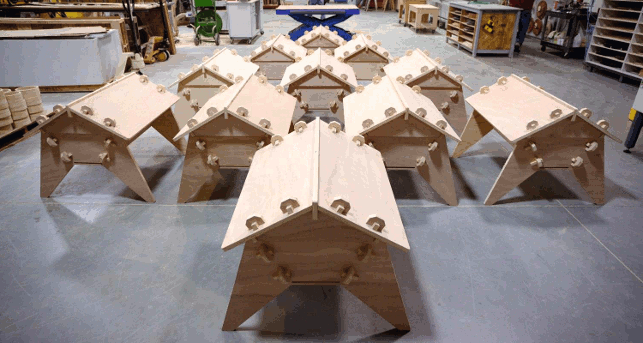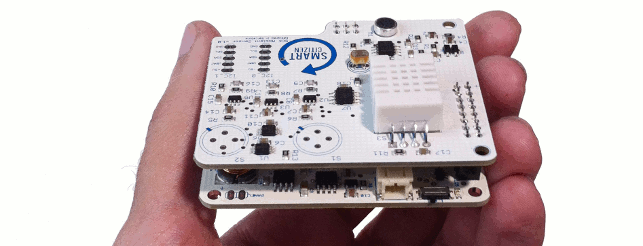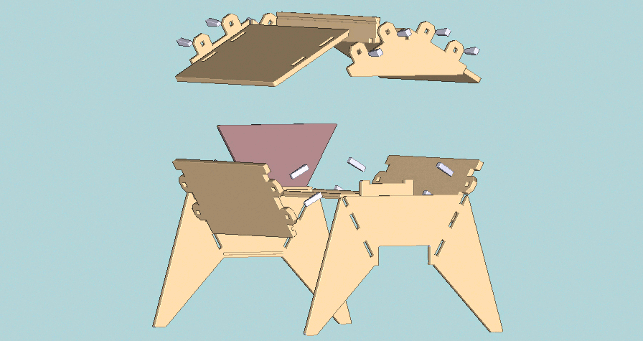There has been a lot of publicity about honey bees in recent years. By now we pretty much have it drummed into us how vital these tiny creatures are. But they’re still under threat, some threats unexplained as in the Colony Collapse Disorder. Simply put, more studies need to be carried out to ensure these pollinators stick around.

Colorado Top Bar hives ready to be shipped to US backers from Denver
The Open Source Beehives (OSBH) project hopes to provide a solution to this problem by building a global
community of beekeepers to share data and collectively study bee behaviour.
The first part of the project is the design of two ‘biodynamic’ beehives – the Colorado Top Bar and the Barcelona Warré – which can be easily CNC machined from downloadable files, assembled and placed on a rooftop or garden.
The second part is the development of a sensor kit that is placed inside the hive to monitor what’s going on inside. The sensors will connect to the internet and the logged data will be streamed to an online platform, where it will be openly available for public analysis.
Bee aware
The OSBH project is a collaboration between Fab Lab Barcelona – a state-of-the-art digital fabrication space, one of many such spaces throughout the world that aim to democratise access to manufacturing – and the Open Tech Collaborative in Denver, US, which develops open source commercial products.

The Barcelona Warré offers a different hive design, which is more popular with Europeans
Tristan Copley Smith and Aaron Makaruk, partners at the Open Tech Collaborative, started to think about how the open source movement could respond to bee decline and by chance Smith visited the Fab Lab Barcelona where he met Jonathan Minchin, who, amongst other projects , was working on hive monitoring.
The idea for the OSBH project was hatched – combine open source designs, low cost manufacturing and robust sensors to help alleviate bee decline.
But what exactly is an open source project? Well, unlike traditional product development models where designs are created in secret and patented, open source allows a product’s design to be freely accessible to everyone who can then share and improve on the design to collectively contribute to a solution.
“As part of the maker movement, it’s abundantly clear that Fab Labs wouldn’t be able to do a fraction of the things we do under the patent system,” admits Minchin.
“Although I’m not against the older way of conceiving and developing knowledge and taking products to market, I just think it doesn’t fit with how people work today. We need other modes of production.”
Busy bees
Minchin was tasked with designing the hives and from the outset the goal was to machine them from a single 1220 x 2440mm wooden board using a CNC router.
“We have access to a large gantry 3-axis ShopBot CNC milling machine at the Fab Lab so it made sense to be able to use that machine to produce flat-pack hives. We also thought that CNC would be the most popular production mode, enabling people to make their own if they had access to a Fab Lab or something similar.”

The Smart Citizen Sensor Kit that will be adapted to monitor bee health from inside the hive
They chose to adapt two traditional top bar hives – the Kenyan top bar with its large hive space and the Warré hive, a stacking design invented by a French beekeeper in the early 1900s. “We were very attracted to the Warré especially as it’s known as the ‘people’s hive’ so it’s almost the first true representation of open design.”
Minchin designed both the Colorado Top Bar and Barcelona Warré using Rhino. “I think we use Rhino for the simple reason that we can hack it quite easily developing our own plug-ins and scripts,” he smiles.
As Minchin was essentially adapting each design for digital fabrication he didn’t stray too far from the originals in terms of the volume, the bee space and the functionality of the hives themselves. What he was experimenting with, however, was different types of lock fit as a key feature of the hive is that they’d require no screws to build.
Using 20mm thick plywood, many prototypes were machined before the final design was settled on. There were about 16 of the Warré and eight of the Top Bar, being a more simple design.
“I had to really think about how the tool paths can be made and see how that translates back into the design. It’s just a simple nesting design but there is quite a lot of small or fine adjustments to think of,” he describes.
Of course, this project is also about the sensors that will be placed inside the hives. These will be adapted from the Smart Citizen platform, which has been developed by Fab Lab Barcelona and the Institute for Advanced Architecture of Catalonia (laac).
“We’ve developed the Smart Citizen Kit, which at its core is an adapted arduino [open-source electronics prototyping platform] that publishes data to the Smart Citizen platform. The sensor shield on the kit is used for cities measuring ambient noise, light, humidity, temperature and pollutants. That shield is replaceable and we’ve been developing new ones for urban agriculture including one for beehives.

A screenshot of the Colorado Top Bar hive in Rhino
“Of course a beehive is very different to a city so we have a real job on our hands to be able to create a monitoring system that is non-intrusive but publishes useful data for scientists and local beekeepers.”
What’s the buzz
To help fund the development of this sensor, the OSBH team decided to launch a crowdfunding campaign on Indiegogo with a $20,000 goal. “Also, I think crowdfunding goes hand in hand with the idea of open source and freely publicising designs to a community and then asking the community at large to help fund your work,” says Minchin.
The perks ranged from $1 to be listed as a supporter and $15 to download both the Colorado Top Bar and Barcelona Warré design files through to $450+ for a ready made hive shipped to your front door.
When the campaign closed on 25 April 2014 the project was 315 per cent funded with a final amount of $63,057. “It’s interesting to see who has picked up on the campaign. There’s been concerned beginner beekeepers but the majority of the backers are young makers already connected to maker spaces and Fab Labs who are interested in beekeeping.
“But we have pretty much been ignored by most of the expert beekeeping community. They are probably rather skeptical of the project but hopefully when they see what we are doing, they’ll be more supportive,” says Minchin.

A 3D model showing the different elements of this wooden, flat-pack hive design
Backers have also received the files so they can produce the hives themselves. These source files include: Rhino – the 3D model and nesting file, the STL export file to load the model into web viewers; the DXF file containing the cutting strategies to load into the user’s CAM software to create the machine tool paths; and another STL file containing 3D information to cut an angle using CAM software.
“For me one of the most interesting things is to see what people do with the files. It’s one thing to call the design open but whether it’s in a Rhino file, G-code or a nesting DXF file – does that really work? How do we do distributed manufacturing with CNC? It’s really all just an experiment.”
Some of the backers have already machined and assembled their hives sending photos to the OSBH team. In fact, a lady in Idaho used the Rhino file to adapt her hive to a specific thickness of local wood and even created a new fitting that she embellished in a flowery pattern.
“I’ve gone through a learning curve myself with the response from the community and not only adapted the hive design but I’m also going to send the files out in Rhino as well as Blender and Inkscape, both of which are free and open source software products. This way anyone can tinker and adapt the designs themselves.”
But this is just the start of the project, and the OSBH team would love to get more people onboard to develop sensors, help build infrastructure for the data and create new variations of the hives.
“Imagine a global network of hives, all feeding an open database of insights into honey bee health,” says Minchin. “If things take off, we could be generating valuable crowd sourced data to influence policy change, and practising true grass roots democracy. It’s really quite exciting.”
The Open Source Beehives team will be at FAB10Barcelona from 2 to 8 July 2014, the international conference and annual meeting of the global Fab Lab network. It’s open to anyone who is interested in the applications and implications of digital fabrication.
In the meantime, in the next issue of DEVELOP3D look out for an article on Fab Labs in the UK.
A look at the design process and aims of the Open Source Beehive Project
Default






